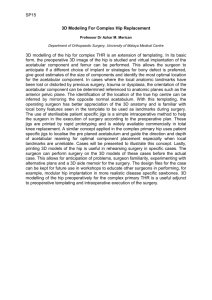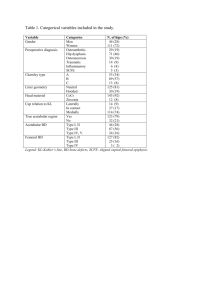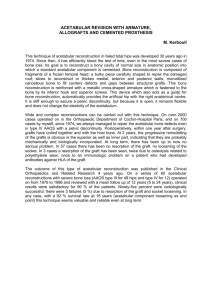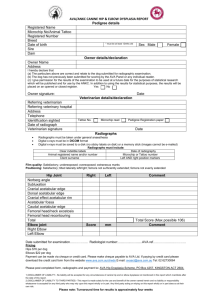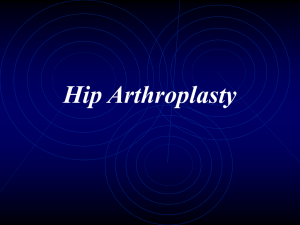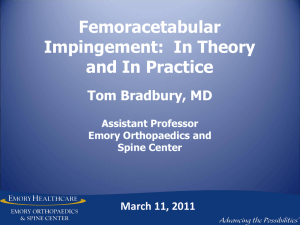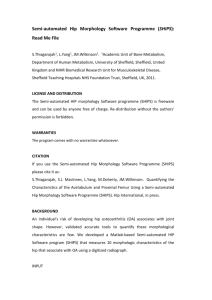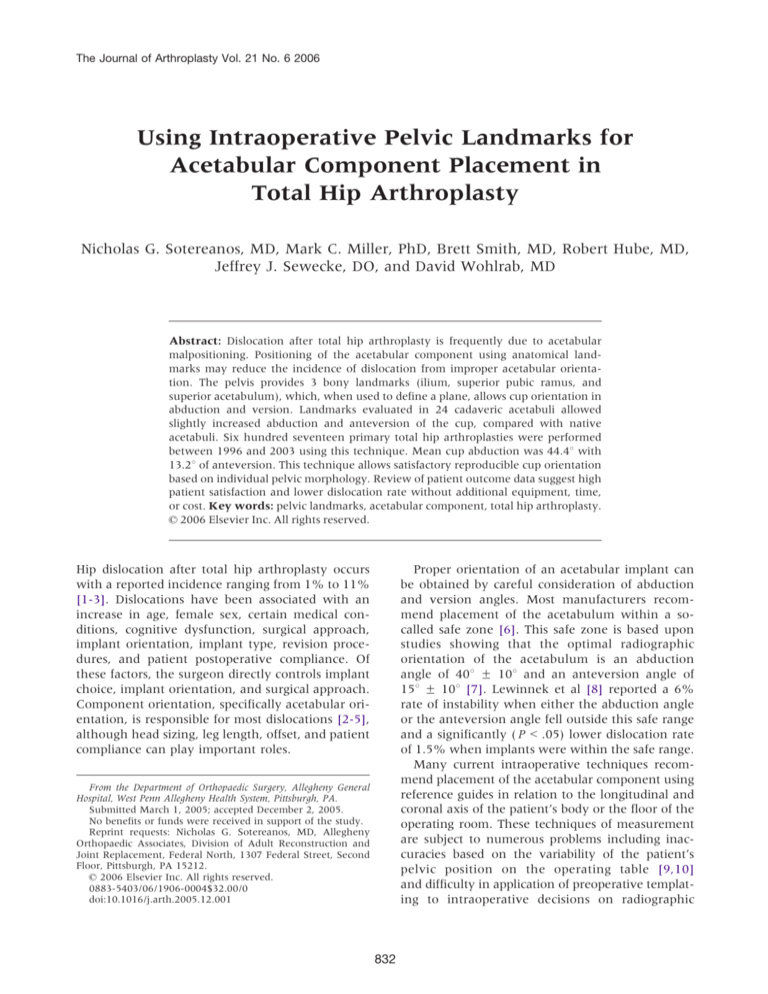
The Journal of Arthroplasty Vol. 21 No. 6 2006
Using Intraoperative Pelvic Landmarks for
Acetabular Component Placement in
Total Hip Arthroplasty
Nicholas G. Sotereanos, MD, Mark C. Miller, PhD, Brett Smith, MD, Robert Hube, MD,
Jeffrey J. Sewecke, DO, and David Wohlrab, MD
Abstract: Dislocation after total hip arthroplasty is frequently due to acetabular
malpositioning. Positioning of the acetabular component using anatomical landmarks may reduce the incidence of dislocation from improper acetabular orientation. The pelvis provides 3 bony landmarks (ilium, superior pubic ramus, and
superior acetabulum), which, when used to define a plane, allows cup orientation in
abduction and version. Landmarks evaluated in 24 cadaveric acetabuli allowed
slightly increased abduction and anteversion of the cup, compared with native
acetabuli. Six hundred seventeen primary total hip arthroplasties were performed
between 1996 and 2003 using this technique. Mean cup abduction was 44.48 with
13.28 of anteversion. This technique allows satisfactory reproducible cup orientation
based on individual pelvic morphology. Review of patient outcome data suggest high
patient satisfaction and lower dislocation rate without additional equipment, time,
or cost. Key words: pelvic landmarks, acetabular component, total hip arthroplasty.
n 2006 Elsevier Inc. All rights reserved.
Proper orientation of an acetabular implant can
be obtained by careful consideration of abduction
and version angles. Most manufacturers recommend placement of the acetabulum within a socalled safe zone [6]. This safe zone is based upon
studies showing that the optimal radiographic
orientation of the acetabulum is an abduction
angle of 408 F 108 and an anteversion angle of
158 F 108 [7]. Lewinnek et al [8] reported a 6%
rate of instability when either the abduction angle
or the anteversion angle fell outside this safe range
and a significantly ( P b .05) lower dislocation rate
of 1.5% when implants were within the safe range.
Many current intraoperative techniques recommend placement of the acetabular component using
reference guides in relation to the longitudinal and
coronal axis of the patient’s body or the floor of the
operating room. These techniques of measurement
are subject to numerous problems including inaccuracies based on the variability of the patient’s
pelvic position on the operating table [9,10]
and difficulty in application of preoperative templating to intraoperative decisions on radiographic
Hip dislocation after total hip arthroplasty occurs
with a reported incidence ranging from 1% to 11%
[1-3]. Dislocations have been associated with an
increase in age, female sex, certain medical conditions, cognitive dysfunction, surgical approach,
implant orientation, implant type, revision procedures, and patient postoperative compliance. Of
these factors, the surgeon directly controls implant
choice, implant orientation, and surgical approach.
Component orientation, specifically acetabular orientation, is responsible for most dislocations [2-5],
although head sizing, leg length, offset, and patient
compliance can play important roles.
From the Department of Orthopaedic Surgery, Allegheny General
Hospital, West Penn Allegheny Health System, Pittsburgh, PA.
Submitted March 1, 2005; accepted December 2, 2005.
No benefits or funds were received in support of the study.
Reprint requests: Nicholas G. Sotereanos, MD, Allegheny
Orthopaedic Associates, Division of Adult Reconstruction and
Joint Replacement, Federal North, 1307 Federal Street, Second
Floor, Pittsburgh, PA 15212.
n 2006 Elsevier Inc. All rights reserved.
0883-5403/06/1906-0004$32.00/0
doi:10.1016/j.arth.2005.12.001
832
Intraoperative Pelvic Landmarks ! Sotereanos et al 833
Fig. 1. Photograph of pelvis defining anatomical landmarks: the lowest point of the acetabular sulcus of the
ischium (point A), the prominence of the superior pelvic
ramus (point B), and the most superior point of the
acetabular rim (point C).
in abduction and version. These landmarks, described in more detail below, are the prominence
of the lateral aspect of the superior pelvic ramus,
the lowest point of the acetabular sulcus of the
ischium, and the most superior point of the
acetabular rim (Fig. 2A). These landmarks can be
readily identified intraoperatively. Furthermore,
the landmarks are easily discerned from osteophyte
formation and, in most circumstances, are still
present with erosive bone defects secondary to
osteolysis. The purpose of this work is to describe
the surgical application of these landmarks, to
establish the topology described by these landmarks, and to document the clinical success of
acetabular positioning.
Clinical and laboratory investigations were undertaken to prove the efficacy of these landmarks
in placement of acetabular components. The clinical investigation involved surgical application of
the landmark use with careful tracking of the
patient. The laboratory investigation used in vitro
measurement to establish a relationship between
the native anatomical orientation of the acetabulum and the resulting component orientation.
Materials and Methods
landmarks. McCollum and Gray [9] attempted to
improve the intraoperative accuracy of component
placement by using a line determined by the
anterior superior iliac spine (ASIS) and the sciatic
notch, reducing dislocations to 1.14%. Their technique still required judgment and did not assess the
orientation of the acetabulum anatomy. Recently,
computers have been suggested as an alternative
combining preoperative radiographic data to intraoperative component orientation. DiGioia et al used
computed tomographic (CT) scans and computerized component guidance to minimize dislocation in
a small group of patients [11]. Although this
technique demonstrates promise, the high financial
costs and limited availability restricts the usefulness
in routine daily application in all centers performing
hip arthroplasty. Currently, no system is universal
or allows reproducible accurate placement of the
acetabular component.
The use of osseous pelvic landmarks was derived
from considerations in elementary geometric relationships. The outer rim of the acetabular component defines a single plane in space. The planes of
abduction and version describe the positioning of
this component within the acetabulum. Likewise,
3 bony landmarks on the patient’s pelvis form a
plane that can be used to position the component
Use of Landmarks in Cup Placement:
Geometric Details
Adequate placement of the acetabular component demands orienting the prosthesis within the
confines of the acetabulum after reaming. The
position must approximate the pelvic and femoral
anatomical relationships to provide coverage of the
femoral head. The relationship avoids dislocation
by maintaining stability within the physiological
arc of motion. The orientation of the acetabular
component is based upon the prosthetic rim
guiding planes of reference. The outer rim of the
component forms a plane, and any 3 points on the
rim define the plane. The reamed acetabulum
confines the component location. However, once
the component is within the acetabulum, specification of any 2 points on the rim completely
defines cup orientation provided they do not lie
on a line through the center. Thus, 2 bony landmarks in combination with the prosthetic rim
location can define acetabular component orientation. The method of component placement in this
study uses the acetabular confines and bony landmarks in conjunction with preoperative templating. The method allows consistent component
orientation, thereby decreasing the possibility of
dislocation secondary to malposition [9].
834 The Journal of Arthroplasty Vol. 21 No. 6 September 2006
Fig. 2. Photograph demonstrating incorrect vertical
orientation of the acetabular component. The vertical
position is represented by the overhanging of the
component distal to the acetabular notch at the inferior
aspect of the acetabulum (A). If the inferior acetabular
fovea is located, no component overhang should be
present inferiorly.
The landmarks used in this study to orient the
cup are shown in Fig. 1. The first point, A, is on the
ischium and is the lowest point in the sulcus or
groove between the acetabulum and the ischeal
tuberosity. Intraoperative identification of this
point can be accomplished by sliding a Cobb
elevator over the acetabular rim along the ischium
until reaching the lowest point of the sulcus. The
second point, B, is located on the lateral portion of
the superior pubic ramus. The point is located at
the confluence of the inferior aspect of the
iliopectineal eminence and the pubic rami. This
point is readily distinguishable although not an
eminent osseous landmark. In following the ridge
of the ramus toward the acetabulum, the point can
be clearly seen or palpated and is approximately
5 mm from the acetabular rim. In 24 pelvises
measured in the laboratory, the prominence was
5.2 F 1.0 mm from the reamed edge of the
acetabulum. Should the surgeon have any doubts
regarding correct identification of the prominence,
a point on the ridge approximately 5 mm from the
reamed acetabulum will suffice.
After identification of the first 2 landmarks, the
acetabulum is serially reamed to the measured
templated diameter. The orientation of the reamer
and component is positioned according to the plane
defined by the rim of the component passing
through the 2 landmarks and medialized to the
acetabular fossa. An important principle of this
technique is the inferior portion of the acetabular
component must be positioned to avoid inferior
overhang of the acetabular notch.
This is represented by component templating
superior to a horizontal line at the inferior aspect of
the acetabular teardrop on the anteroposterior (AP)
pelvis radiograph. Intraoperatively, confirmation
can be determined by placement of a Homan’s
retractor at the inferior aspect of the acetabular
notch. The component rim must be placed at the
level of the retractor. If the acetabulum is appropriately reamed to diameter, any evidence of
inferior component overhang will orient the component in a more vertical position than anticipated
in the preoperative template (Fig. 2). Conversely, if
bone is visible inferior at the acetabular notch and
the inferior aspect of the cup, malorientation in a
more horizontal position will occur (Fig. 3).
Although the 2 landmarks in conjunction with
reamed acetabular relationship to the acetabular
notch will suffice to orient the component, a third
point, point C in Fig. 1, is used to confirm correct
component placement. The third point is the most
superior point of the acetabulum, which intraoperatively is equivalent to establishing the overhang of
the acetabular cup; when viewed radiographically,
the most superior point is also the most lateral. Once
the component is correctly placed in the reamed
socket, the amount of component overhang is
measured from this point. If the component has
been placed correctly, the intraoperative measured
distance of overhang will be consistent with the
templated assessment, as measured in millimeters.
Fig. 3. Photograph demonstrating horizontal orientation of the acetabular component. The horizontal position is represented by the ability to visualize acetabular
bone inferior to the rim of the component (A)
and overhang superiorly (B), as referenced via preoperative templating.
Intraoperative Pelvic Landmarks ! Sotereanos et al 835
Clinical Investigation
Fig. 4. Abduction angles associated with position of
the superior lateral landmark and corresponding x-ray of
the pelvis.
The component orientation is completely defined by
the 2 points inside the reamed socket in combination
with the confines imposed by acetabulum and the
notch. The final amount of the component overhang of the bony acetabulum should agree with
preoperative templating.
Component placement is templated on preoperative radiographs by using standard landmarks, as
shown in Fig. 4. Using a standard AP film, a
horizontal line is drawn connecting the inferior
points of the teardrop for both acetabuli. Using this
line as a reference, a perpendicular line is then
drawn along the lateral border of the teardrop
representing the amount of cup medialization.
Using standard templates provided by the implant manufacturer, the acetabulum is first sized.
Then, the inferior corner of the acetabular template
is placed on the horizontal line with the backside of
the cup touching the vertical line such that the cup
face forms a 408 angle with the horizontal. The new
hip center of rotation is marked, and the amount of
cup that is uncovered over the superior-lateral
acetabulum is noted; this is defined as overhang.
The templating concludes with the femoral
implant. The change in hip center of rotation will
reduce the offset from the patient’s inherent offset
length, and this change must be considered in
planning the femoral neck resection and choosing
the type of femoral implant. The x-rays are used
intraoperatively to confirm the position of the cup.
The component should be placed on the inferior
portion of the teardrop, and the extent of the
lateral overhang should match the templated films.
If the templated and intraoperative component
placements do not agree, then repositioning of
the cup is necessary until intraoperative landmarks
and preoperative templates match.
Between 1996 and December 2003, 617 consecutive primary total hip arthroplasties were performed by the senior physician (NGS). Criteria for
inclusion were advanced degenerative joint disease, rheumatoid arthritis, ankylosing spondylitis,
avascular necrosis, inflammatory arthritis, and
posttraumatic arthritis. Femoral fixation was based
on the patient’s age, bone quality, and underlying
medical comorbidities. A Morse taper, 28-mm head
segment, with variable neck length was used to
adjust soft tissue tension. Acetabular fixation was
achieved in all patients using a cementless component. The acetabular shells were titanium alloy
with porous coating and cluster holes (Trilogy;
Zimmer, Warsaw, Ind). Exclusion criteria included
previous hip surgery.
Preoperative templating was performed in all
patients. On the AP pelvic radiograph, standard
measured templates were used to approximate the
circumference and estimated size of the acetabulum. The acetabular component was templated in
reference to the acetabular teardrop. The inferior
medial portion of the component was positioned
lateral and not inferior to the teardrop. The superior
cup overhang from the lateral aspect of the
acetabulum was measured in millimeters (Fig. 4).
All surgeries were performed using a modified
Hardinge approach. The hip was dislocated, and
neck osteotomy was preformed. The acetabulum
was exposed, followed by a capsulotomy to identify
specific bone landmarks: the prominence of the
superior pubic ramus, the lowest point of the
acetabular sulcus of the ischium, the superior
acetabular rim, and the acetabular notch. These
points were used to conceptualize a plane of the
acetabular orientation in abduction and version.
Acetabular reaming was performed in relation to
the conceptualized acetabular orientation. The
acetabular implants were placed in accordance to
the template and bony landmark identification. No
other utilities were used for acetabular orientation
intraoperatively. After implantation of the femoral
component, stability tests through out full range of
motion were done during surgery.
The 2 points on the inside of the reamed surface
at the levels of the 2 inferior bony landmarks can be
readily visualized (Fig. 1A and B). The rim of the
component must pass through these 2 visualized
points, and the cup will overhang the acetabulum
by the amount determined as measured in millimeters during preoperative planning (Fig. 4). In
effect, the line connecting the 2 inferior points
assures the appropriate anteversion, whereas the
836 The Journal of Arthroplasty Vol. 21 No. 6 September 2006
Fig. 5. The device for the measurement of acetabular
orientation. The 3 prongs were used to determine the
acetabular plane. The scales used to read the orientation
are at the left end of the device.
measured overhang derived from templating assures the appropriate abduction. Intraoperatively,
there were no jigs or other devices used to check
the cup positioning. No postoperative abduction
pillows were used.
Physical therapy was initiated on postoperative
day 1. The weight-bearing status was determined
by femoral fixation. All patients with cemented
femoral components were weight-bearing as
tolerated and cementless implants were partial
weight-bearing. Physical therapists instructed all
patients in hip precautions limiting hip flexion
to less than 908. Follow-up occurred at 2 weeks,
1 month, 3 months, 6 months, 12 months, and
each year.
All of the patients were examined both clinically
and radiographically at each follow-up visit by the
senior author. The patients were evaluated using
the Harris Hip Score at the 1-year evaluation.
The soft tissue of each pelvis was removed to
allow accurate assessment of bony anatomy and to
optimize radiographic visualization of bone. Upon
completion of the soft tissue removal, small metallic
tacks were placed in the prominence of the superior
pubic ramus, the lowest point of the acetabular
sulcus of the ischium, and the most superior point
on the acetabular rim of each acetabulum. These
tacks represent the described anatomical landmarks,
and the radiographic location is shown in Fig. 6.
These tacks were used as the points to obtain
measurements of the abduction and anteversion
and suggest orientation of the native acetabulum.
Radiographs were obtained for each of the pelvises
including an AP view of the pelvis, an individual hip
AP view, and shoot-through lateral hip. Each pelvis
was preoperatively templated to determine a radiographic abduction and the overhang of the implant
at the superior acetabular rim.
The ASISs and the pubic tubercles of each pelvis
were drilled and secured with wood screws to a flat
10-mm-thick polymethylmethacrylate plate. This
fixation placed the pelvis in a reference position
referred to as the anterior pelvic plane [12]. Each
pelvis was placed in the 3-dimensional coordinate
measuring device. The orientation of the plane
parallel to the acetabulum was ascertained by
touching the tip of a prong to the head of each
tack. This plane was labeled as the acetabular plane
and was taken as the preoperative measurement of
acetabular orientation. The angles describing the
orientation of the plane defined by the plane were
read directly from the device, and these angles
were converted into anatomical abduction and
anteversion. Therefore, the abduction angle was
Laboratory Investigation
To determine the accuracy of this new positioning method, in vitro measurements of the native
and implanted acetabulum were performed.
Twelve cadaveric pelvises without arthritic degeneration and acetabular osteophytes were analyzed
in the laboratory using a special measuring apparatus to determine abduction and anteversion
angles (Fig. 5). The orientation of each acetabulum
was performed in a plane defined by the 3 relevant
bony landmarks (Fig. 1). This definition satisfactorily identifies acetabular orientation because the
pelvises were free of osteophytes.
Fig. 6. Radiograph of a pelvis used in the laboratory
study demonstrating tacks to mark the bony landmarks
and the radiographic orientation of the cups after
implantation. The larger screws hold the pelvis to the
measurement device.
Intraoperative Pelvic Landmarks ! Sotereanos et al 837
Table 1. Postoperative Radiographic Data of
150 Primary Total Hip Arthroplasties
Cup abduction angle* (degree)
No. (%) of cups with abduction of 308 to 508
No. (%) of cups with abduction angle b308
No. (%) of cups with abduction angle N508
Cup anteversion angle* (degree)
No. (%) of cups with anteversion of 58 to 158
No. (%) of cups with anteversion b58
No. (%) of cups with anteversion N158
44.4 (24-58)
139 (96.0)
2 (1.3)
4 (2.7)
13.2 (1-25)
136 (90.7)
2 (1.3)
12 (8.0)
*The values are given as the average and the range in
parentheses.
recorded as the elevation of the acetabular axis
from the transverse plane, and anteversion was the
rotation of the component about the superiorinferior axis of the pelvis.
All 24 acetabuli were reamed to the size deemed
appropriate by the senior physician (NGS). Each
acetabular shell was pressed into place in accordance with the technique described above. Measurements were performed with the custom
apparatus of the postoperative component orientation on the 24 postoperative acetabuli using the
3 prongs on the device to touch the rim of the cup.
Statistical analysis of the measurements was conducted using paired t tests with a Bonferroni
correction for 2 measures, setting the level of
significance at .05.
posterior dislocation occurred during a seizure
during extubation in the operating room. Both
cases were reduced with conscious sedation and
treated with hip abduction orthosis for 12 weeks.
There was 1 late dislocation at 2 years, which was
treated in an abduction orthosis. The other 2 dislocations occurred in the first 3 months after
surgery were treated in abduction orthosis with
no further dislocations. There were no subsequent
dislocations and no revision surgeries for all
dislocations. At an average follow-up of 4.5 years,
the dislocation rate was 0.81% (5/617).
Of the 617 patients, 10 were lost to follow-up
and 6 died. Of the 6 deaths, contacted family
members reported no dislocations before death.
The average postoperative Harris hip score for all
patients was 84, ranging from 34 to 97.
Laboratory Investigation
In the cadavers, 24 acetabuli were measured
preoperatively and postoperatively to determine
the abduction and anteversion angles. These angles
were measured using the anterior pelvic plane, as
defined by the 2 ASISs and the 2 pubic tubercles. In
Table 2. Native Cadaver Acetabulum Orientation and
Postoperative Cadaver Acetabulum Orientation with
Acetabular Implants Inserted
Native
cadaver
acetabulum
Results
Clinical Investigation
In 150 hips, we measured the cup abduction and
version postoperatively. The measured mean cup
abduction angle, using the method described by
Widmer [13], was 44.48 (range, 248 to 588).
Components were defined as outliers when the
cup abduction angle was out of the range of 308 to
508. In only 4 (2.7%) of 150 procedures were the
measured cup abduction angles greater than 508. In
2 (1.3%) of 150 the measured cup abduction angle
was lower than 308 (Table 1). The measured mean
cup anteversion, using the method described by
Widmer, was 13.28 (range, 18 to 258). Components
were defined as outliers when the cup was out of
the range 58 to 158. In only 12 (8.0%) of 150 were
the measured cup anteversion angle greater than
158, and in only 2 (1.3%) of 150 were the
measured cup anteversion angles lower than
58(Table 1). Five patients suffered dislocation.
One posterior dislocation occurred at 4 months
while the patient was using a recumbent bicycle
during a physical therapy session. The second, a
Postoperative
cadaver
acetabulum
Pelvis Hip Abduction Anteversion Abduction Anteversion
1
2
3
4
5
6
7
8
9
10
11
12
Mean
SD
Left
Right
Left
Right
Left
Right
Left
Right
Left
Right
Left
Right
Left
Right
Left
Right
Left
Right
Left
Right
Left
Right
Left
Right
45.3
44
45.9
49.5
53
50.5
56.1
49.1
52.8
47.7
44.7
45.5
49.3
45.5
45.8
42.1
34.6
32.3
30.8
35.1
25.1
23.4
45.9
53.7
43.6
7.9
23.9
22.8
21.6
25.0
20.1
21.4
20.3
22.8
22.0
23.8
20.7
21.5
17.7
20.0
20.7
18.2
16.9
14.3
23.4
22.1
32.0
32.1
21.6
20.9
22.0
4.1
30.0
32.5
32.0
30.7
30.9
33.4
32.9
34.3
24.7
26.8
31.0
30.8
30.9
31.6
30.1
31.1
25.8
24.1
30.4
32.9
30.1
23.8
30.1
30.2
30.0
9.3
21.4
24.9
22.4
24.9
23.1
24.8
21.8
24.7
45.7
44.1
24.8
23.5
25.0
26.7
19.7
23.0
20.9
25.1
24.6
25.1
23.1
23.3
25.8
24.6
26.6
9.7
838 The Journal of Arthroplasty Vol. 21 No. 6 September 2006
the preoperative pelvis, the acetabular plane was
measured by a plane defined by the 3 tacks, and the
acetabular component plane was recorded in
reference to the rim of the component. Results for
all acetabuli and cups are recorded in Table 2. The
postoperative abduction results were 13.68 less
than the preoperative native values, showing less
anatomical abduction of the component. The
postoperative anteversion angle was 4.68 greater
than the native. The paired t test comparisons
including Bonferroni correction showed statistical
significance in both abduction and anteversion
angular differences.
Discussion
Dislocations are disturbing for both the patient
and physician and involve a significant expense.
Preventive strategies are the appropriate remedy
and can be divided into 3 broad categories:
preoperative, intraoperative, and postoperative.
Preoperatively, important steps include a thorough
history, a complete physical exam, radiographic
evaluation, and templating.
Intraoperatively, the surgical approach, implant
orientation, soft tissue tension, and implant selection affect rates of dislocation [2,3]. Postoperatively, patient education and hip motion precautions
can also prevent dislocation.
This study reviews the single variable of acetabular component position in hip dislocation. The
study reports excellent clinical results and defines
laboratory measurements with the use of local
anatomical bone landmarks to position the acetabular component. The overall dislocation rate was
0.81% (5/617), without consideration of the etiology. When the case of the intraoperative seizure
resulting in a dislocation was not included, only
4 patients (0.64%) suffered a dislocation.
There is currently no method in total hip
arthroplasty using the patient’s visible bony landmarks as an intraoperative reference for acetabular
implant placement without the need for additional
equipment or extensive preoperative imaging.
Recently, Jaramaz et al [14] combined preoperative
CT imaging with intraoperative application of
specialized computerized equipment to standardize
acetabular component orientation. Unfortunately,
this method requires additional equipment, time,
cost, and resources. The proposed method described in this paper can be used effectively in
any setting in which hip arthroplasty is performed.
The laboratory measurements suggest the
implanted component anteversion and abduction
would provide greater posterior and superior
coverage than the native orientation of the acetabulum. The difference in the abduction and
anteversion angle was statistically significant. The
component abduction was substantially less than
the native abduction and indicates an increase in
superior coverage of the femoral head. This relationship between the prosthetic femoral head and
acetabular joint surface may be beneficial in establishing greater functional arc of stability because the
reconstructed hip geometric relationships are a
smaller diameter than the native hip joint. The
abduction reflects the resulting overhang of the
acetabular component in the pelvis, as could be
expected from the preoperative template placement. This is demonstrated in the postoperative
radiograph of a laboratory test (Fig. 4). The SDs
between the implanted component orientations
were greater than the SDs of the native acetabular
orientations. This was interpreted to reflect the
technical difficulties in reproducible seating of the
cementless component. Further investigation of
the variability with additional laboratory study
would be beneficial in application to the index
arthroplasty methodology.
The measured values in the current study are
expressed in anatomical terms. The recommendations for component placement can be expressed in
operative, radiographic, or anatomical reference
[15]. An acceptable value of anteversion in radiographic terms is approximately 158 [7] and must
not be directly compared with values determined in
the anatomical frame. Using published conversions
[15], the current anatomical results have a radiographic equivalent of 138 of anteversion and 288 of
inclination. In comparison to the bsafe-zoneQ of
orientations presented by Lewinnek et al [8], the
current method of component placement leads to
an average orientation with anteversion and inclination angles, just outside the suggested range of
158 F 108 of anteversion and 408 F 108 of
inclination. However, the combination resulting
from the current use of bony landmarks could be
considered quite conservative and less likely to
dislocate because all the dislocations in the study of
Lewinnek et al occurred at considerably higher
anteversion and inclination angles. McCollum and
Gray [9] observed the safest range of acetabular
component placement was 308 to 508 of abduction
and 208 to 408 of flexion. In their review, the hip
remained stable and allowed a physiological range
of motion. The current laboratory evaluation of
acetabular component abduction measurement
suggests an increase in superior and posterior
coverage. A possible criticism of this position may
include that the increased anteversion could result
Intraoperative Pelvic Landmarks ! Sotereanos et al 839
in a decrease in hip extension. The lack of this
motion could result in posterior neck impingement
with subsequent anterior dislocation. In addition,
the decreased inclination could limit abduction
causing lateral impingement resulting in an anterior or inferior dislocation. Neither of these concerns has been apparent in the clinical review. The
suggested position, as described in this method,
may increase the coverage of the femoral head
during the functional arc of motion and may result
in a more physiological stable orientation. Further
evaluation is necessary to evaluate this hypothesis.
Placement of an implant outside prescribed
abduction and anteversion ranges has been shown
to increase dislocation rate [14]. Manufacturers
provide intraoperative guides for acetabular implant placement in an attempt to align the implant
with respect to the longitudinal and coronal axes of
the patient [6]. These may be highly inaccurate,
and the difference in orientation between the
patient’s pelvis and the whole body is the most
likely cause for variation [11]. The use of radiographic assessment of acetabular component orientation also has pitfalls. As described by Herrlin
et al [5], radiographic anteversion must consider
the relationship of the radiographic plate to the
source. This requirement is well known but also
means that plane film radiographs must be used
carefully in operative decisions. The need for
consistent acetabular placement has led to development of systems such as the HipNav [11], which
guides acetabular component alignment through
comparison of preoperative CT images with intraoperative measurements of the patient’s pelvis.
Although future advances in technology and
reductions in cost should permit computer assisted
methods to aide all surgeons, simpler techniques
can provide alternatives. The proposed method for
intraoperative placement determines the abduction
and anteversion of the acetabular implant based
strictly on the local pelvic anatomy and can be used
effectively in all operating rooms. Degenerative
changes may obscure the acetabular rim as a
consistent landmark for component placement.
The adjacent landmarks of the pelvis are less likely
to be altered by degenerative changes. The superior
rim of the acetabulum, the prominence of the
superior pubic ramus, and the acetabular sulcus of
the ischium form a triad of bony landmarks that
can be identified consistently in most patients. In
our experience, minimal additional dissection is
required, and the landmarks are usually unaffected
by osteophytic growth. In certain instances, the
superior landmark may be obscured by an osteophyte, but this should be expected from the
preoperative template. The osteophyte may be
removed or used to measure the lateral overhang
of the acetabular component. These landmarks will
form a plane specifying the location of the component rim within the reamed acetabulum. This
technique produces consistent anteversion and
superior coverage.
The recorded dislocation rate of 0.81% is less
than the reported rates commonly associated with
primary total hip arthroplasty [16]. The follow-up
period for this study was, on average, 4.5 years,
ranging from 2.5 to 7 years. Although this study is
shorter than optimal, most dislocations after total
hip arthroplasty occur within the first few months
after surgery. Dorr et al [1] reported that 54% of
dislocations occur within the first 3 months and
85% within 2 years. Late dislocations are often the
result of polyethylene wear and component malposition [1]. The short follow-up is a weakness of
this study. At this interval, it is unclear if satisfactory initial component placement may improve
femoral head coverage and late dislocation.
We conclude that the anatomical bony pelvis
landmarks in combination with preoperative templating are a successful method in assuring proper
acetabular component orientation. The landmarks
obviate the need for mechanical guides, alleviate
the need for expensive navigation equipment, and
lead to a low dislocation rate. These landmarks may
be useful in the standardization of the cup positioning with new approaches in minimally invasive
total hip arthroplasty. Along with intraoperative
range of motion testing, this technique shows
result in dislocation rates less than 1%.
We don’t recommend this method in cases of hip
dysplasia or after fractures of the acetabulum.
Continued follow-up and application of the landmark technique in multiple centers should be
conducted to further evaluate the method in the
hands of multiple surgeons.
References
1. Dorr LD, Wolf AW, Chandler R, et al. Classification
and treatment of dislocations of total hip arthroplasty. Clin Orthop 1983;173:151.
2. Hedlundh U, Sanzen L, Fredin H. The prognosis and
treatment of dislocated total hip arthroplasties with a
22 mm head. J Bone Joint Surg Br 1997;79:374.
3. Turner RS. Postoperative total hip prosthetic femoral
head dislocations. Incidence, etiologic factors, and
management. Clin Orthop 1994;301:196.
4. Daly PJ, Morrey BF. Operative correction of an
unstable total hip arthroplasty. J Bone Joint Surg
Am 1992;74:1334.
840 The Journal of Arthroplasty Vol. 21 No. 6 September 2006
5. Herrlin K, Selvik G, Pettersson H. Space orientation of
total hip prosthesis. A method for three-dimensional
determination. Acta Radiol Diagn (Stockh) 1986;
27:619.
6. Zimmer, Inc. Trilogy Acetabular System Surgical
Technique, in 97-6200-02 rev1. Warsaw, IN: Zimmer; 1998.
7. Herrlin K, Selvik G, Pettersson H, et al. Position,
orientation and component interaction in dislocation
of the total hip prosthesis. Acta Radiol 1988;29:441.
8. Lewinnek GE, Lewis JL, Tarr R, et al. Dislocations
after total hip-replacement arthroplasties. J Bone
Joint Surg Am 1978;60:217.
9. McCollum DE, Gray WJ. Dislocation after total hip
arthroplasty. Causes and prevention. Clin Orthop
1990;261:159.
10. Woo RY, Morrey BF. Dislocations after total hip
arthroplasty. J Bone Joint Surg Am 1982;64:1295.
11. DiGioia AM, Jaramaz B, Blackwell M, et al. The Otto
Aufranc Award. Image guided navigation system to
measure intraoperatively acetabular implant alignment. Clin Orthop 1998;355:8.
12. McKibbin B. Anatomical factors in the stability of the
hip joint in the newborn. J Bone Joint Surg Br 1970;
52:148.
13. Widmer KH. A simplified method to determine
acetabular cup anteversion from plain radiographs.
J Arthroplasty 2004;19:387.
14. Jaramaz B, DiGioia III AM, Blackwell M, et al.
Computer assisted measurement of cup placement
in total hip replacement. Clin Orthop 1998;2354:70.
15. Murray DW. The definition and measurement of acetabular orientation. J Bone Joint Surg Br 1993;75:228.
16. Etienne A, Cupic Z, Charnley J. Postoperative
dislocation after Charnley low-friction arthroplasty.
Clin Orthop 1978;132:19.

